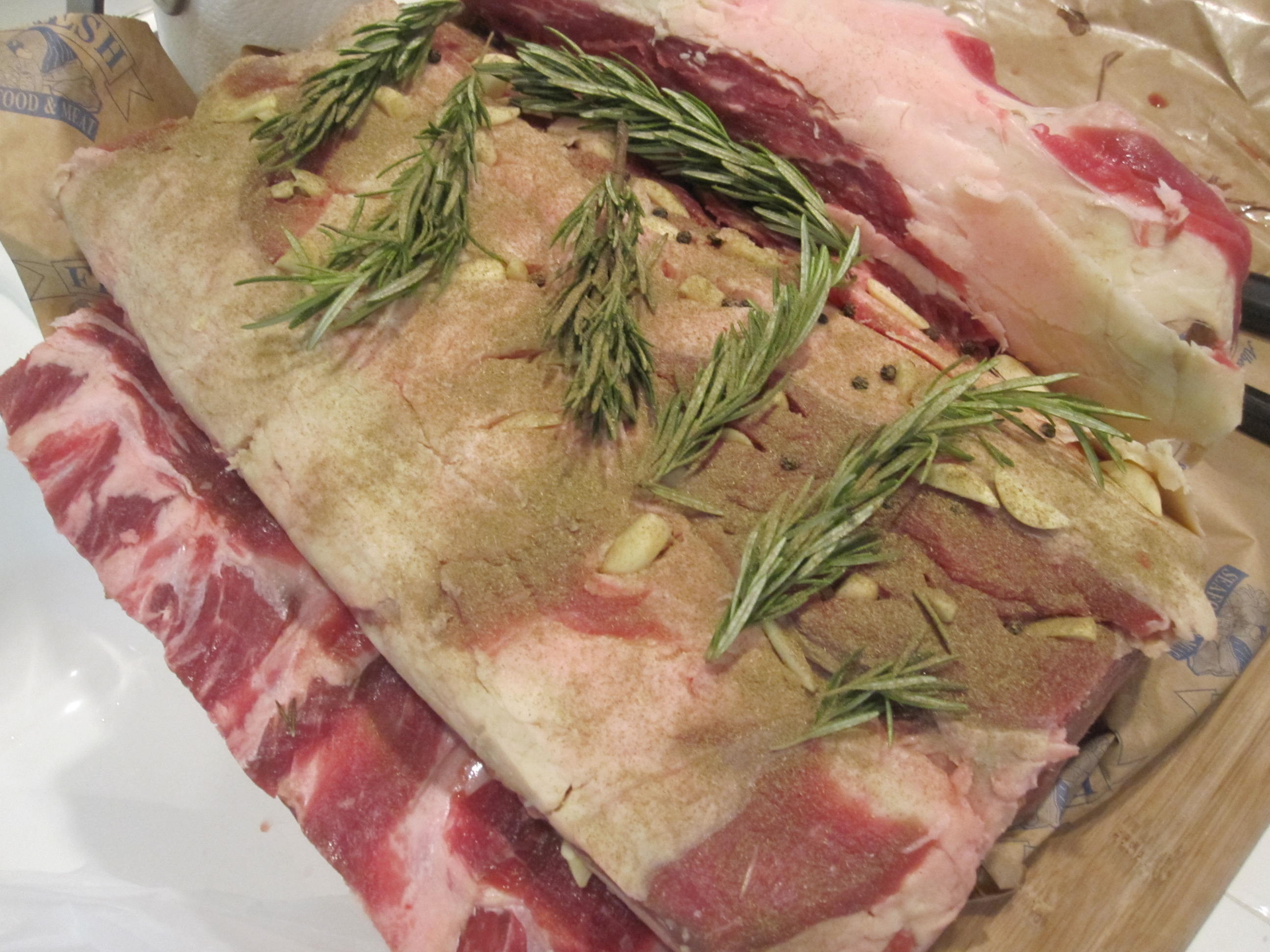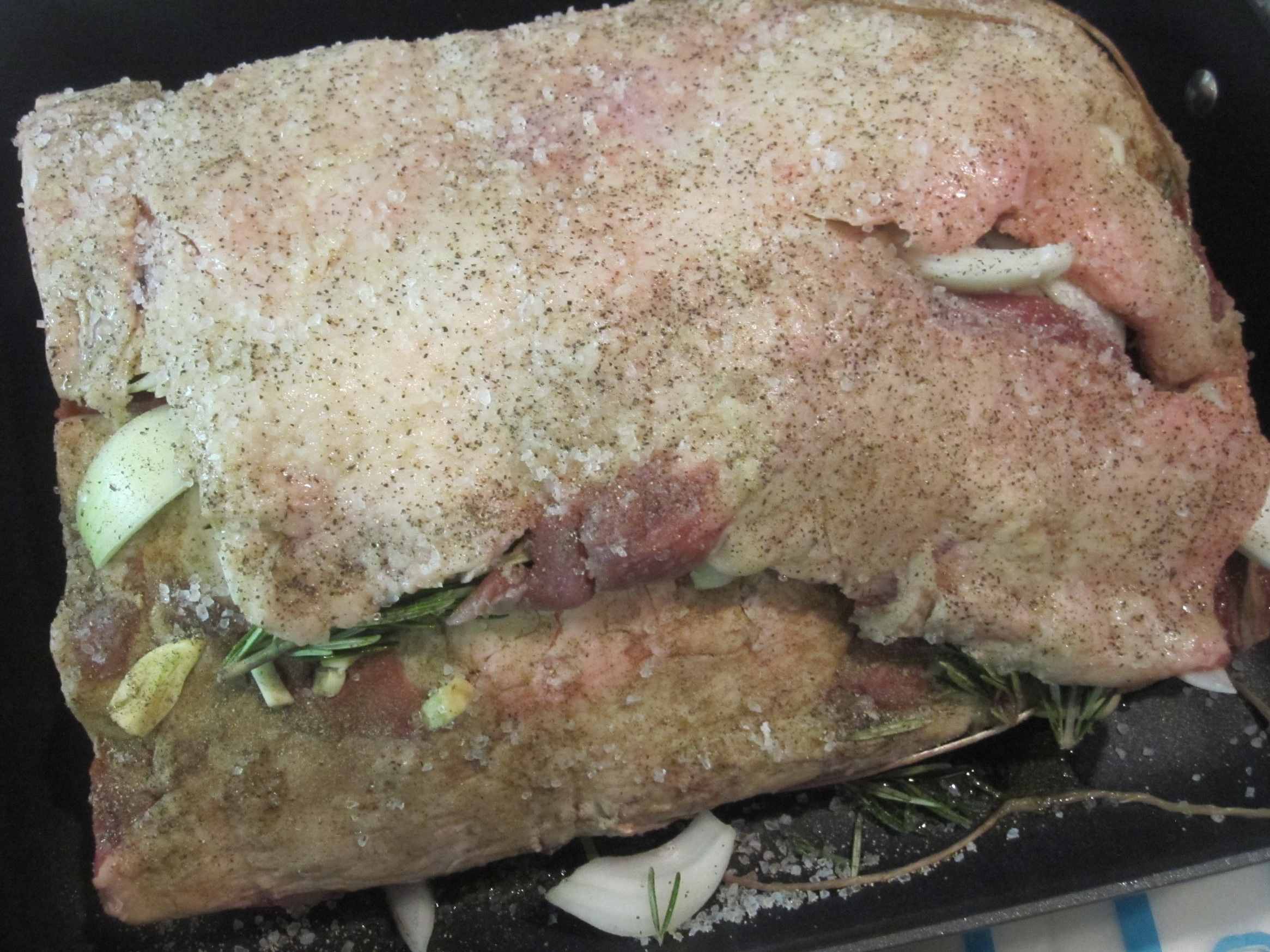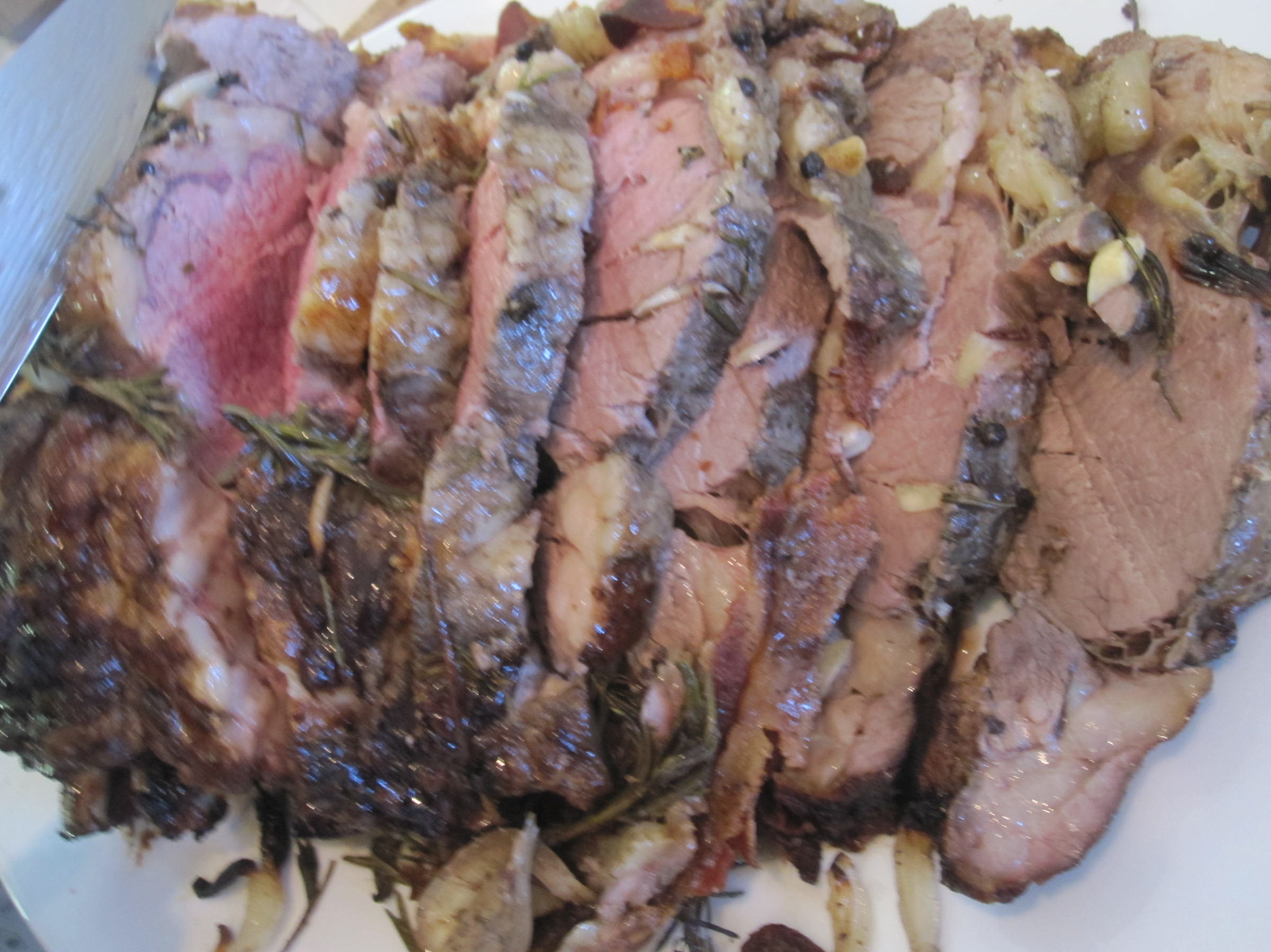Prime Rib
I am a carnivore, and I love beef. Well, I was a lacto-ovo vegetarian for a short period of time, but it was beef that brought me back to being a carnivore once again. In fact, I can’t live without beef, especially prime rib, which is my favorite beef dish and that means Lawry’s is my favorite prime rib restaurant. I’ve celebrated several birthday dinners and special dates with Bebe Dada (who was my boyfriend at the time) at Lawry’s. Growing up, I also remember dining at this special restaurant with my parents for special occasions and entertaining guests from Japan. In my book, if there’s a special occasion to be celebrated, prime rib is the way to go… well, either that or sushi. :)
If I can’t eat prime rib on a special occasion, I am more than happy to order the filet mignon at Mastro’s, Flemings, Morton’s or Ruth’s Chris and at a number of our favorite steak houses in Las Vegas, but since we’ve been blessed with Bebe E’s arrival I am equally as happy eating a UDSA prime filet mignon purchased at Costco and cooked to perfection by Bebe Dada at home.
Unfortunately, as much as I love beef, I can only eat so much of it and I make a conscious effort when I cook for our family (or when I am dining out) to choose lower fat and lower cholesterol fish, chicken or turkey. That said, every once in a while, for a special occasion, a juicy piece of prime rib can be enjoyed guilt-free and with gusto.
One such special occasion where our family eats prime rib is Christmas. (Yes, this might have been a good post for the holidays but by now the handful of people who read my blog know that I am infamous for posting things late and will forgive me.) For years and years my parents roasted a big turkey for Christmas lunch and all I remember while growing up was that we ate turkey for Thanksgiving and turkey for Christmas. Then, about 10 to 15 years ago the mother of a friend of mine shared with me her prime rib recipe and I gave that a try.
My friend’s recipe involved cutting slits all over the prime rib and inserting pieces of garlic, then rubbing the fat cap with olive oil and generously seasoning it with salt and pepper. The recipe seems easy enough, but the first time I made this, it was quite intimidating cooking such a large piece of expensive meat but it turned out OK, for a beginner. It was a little overcooked but my family enjoyed it, especially my brother and my dad.
Over the years, I’ve developed my own recipe for making prime rib, but to this day, I still cut little slits all over the prime rib and stuff them with pieces of garlic, just as I did the very first time using my friend’s recipe. The past several years I’ve watched countless holiday prime rib episodes on the Food Network, and I’ve read equally as many recipes, and every year I’ve tried something a little different, but after 10 – 15 years, I think the latest prime rib that I made was probably the best prime rib yet, despite the fact that every year my brother and the other guys in our family claim how delicious it is.
 It’s awful how the meat shrinks, isn’t it?
It’s awful how the meat shrinks, isn’t it?
Yes, this year I wrapped it in bacon… as if the fat cap wasn’t enough.
I planned to post our prime rib last week in keeping up with my weekly post schedule but life got busy. Bebe Dada was traveling and as usual, I invited my Mom to stay with Bebe E and I to keep us company. It’s actually quite nice when my Mom stays with us because I miss spending time with her. (Dad stays in LA since he has the dogs to look after and he admits he sometimes enjoys the break of being on his own without my Mom. Haha. Is that how it is when you’ve been married for 30-plus years?!?) I know that many of my friends and family are aware that we make a weekly trip to visit Bachan and Jichan for the day, but it’s nice to hang out with my Mom for a few days in my part of town.
When my Mom visits, we usually run errands together to Target and Babies R’ Us or spend some time walking around South Coast Plaza, the Spectrum, or Fashion Island. Other visits when my Mom stays for a longer period of time, I try to plan little field trips to the Laguna Coast, Carlsbad, San Juan Capistrano, or other local destinations. I have to admit that what was great about last week’s visit is that my Mom and I enjoyed take-out dinners and lunches, giving us both a break from the cooking we do for our husbands (kids) and ourselves, as well as the clean-up that comes with it. It’s also nice to have my Mom try different OC eateries. So aside from running errands and enjoying the local shops we simply lounged and enjoyed each other’s company while Bebe E entertained us. It’s funny, but in a way it was a “vacation” of sorts for the both of us.
Bachan and Bebe E Sight-Seeing Locally During Bachan’s OC Visits.
Carlsbad Flower Fields – April 2010;
Laguna Coast & San Juan Capistrano – July 2010
I didn’t always get along with my Mom in my youth but I attribute much of our disagreements to language, generational differences and adolescence. My Mom’s first language is Japanese and she only understands so much in English. Then there’s the fact that my Mom was born and raised in Japan, a country that in the past (and in some ways in the present) held it’s people to high social and cultural standards and the ideal of what is most “proper” and “acceptable” behavior for men, women, children, etc. Since those challenging times of my youth, I’ve since matured and my Mom and I have come to accept and appreciate one another’s differences.
Getting back to the food…. Once I started roasting prime rib for Christmas, my Mom was quite happy because it gave her a break from cooking three holidays meals during the busiest time of the year: Thanksgiving, Christmas, and of course, Oshogatsu. One year, I asked her to prep the prime rib, but she trimmed off all of the fat cap because she thought it was healthier. Oops. After this incident, I was asked by my family to once again resume my prime rib responsibilities.
As with most holiday meats, the biggest task is buying a good prime rib and having enough fridge space to store it. Then, prepping is all you have to do before you let the oven do the rest. If you’ve never prepared prime rib, it’s easier than you might think!
Our Family’s Prime Rib
serves 10 – 12 people
- 1 (about 14 to 16 pound) beef rib, bone in
- 8 to 12 cloves of peeled garlic
- 6 sprigs of fresh rosemary
- Ground thyme (add fresh thyme if available)
- 1 large onion, sliced 1/4-inch thick
- Kosher salt
- Freshly cracked black pepper
- Black peppercorns
- Olive oil
- 6 – 8 slices of thick-cut bacon
1) Preheat oven to 450 degrees F.
2) Slice garlic pieces into halves or thirds. Set aside. Using a sharp knife, make a slit 3/4 of the way up the fat cap. Pull the fat cap back and puncture the meat creating small slits all over prime rib meat (including the sides) with the top 1-inch of a boning knife. Insert garlic pieces in the slits.
3) With the fat cap still pulled back, season the entire roast with a generous amount of ground thyme, several black peppercorns, and 5 to 6 sprigs of fresh rosemary. (Note: I usually use fresh rosemary and fresh thyme, but the market was out of fresh thyme so I improvised with a very generous amount of ground thyme.) I also lightly season with salt and pepper. Next, generously spread fresh onion slices in-between the meat and fat cap. Lay the fat cap back over the onions, spices, garlic and meat.
4) Spread olive oil over the fat cap and using your hands, rub in a generous amount of rock salt. I usually use Hawaiian salt, but since I had a huge box of Kosher salt, I used this instead. Next, heavily pepper the fat cap with fresh ground black pepper.
5) Lay bacon over the fat cap, covering it entirely. You’ll find the bacon will turn crisp and very brown but it isn’t necessarily to eat, it’s really more for added flavor and protecting the top of the rib roast and inner meat (my unprofessional observation). I’ve made several prime ribs without using bacon, but for some reason this year the bacon really worked. Also, a few of the guys enjoyed eating a slice of crisp bacon on the side. ;)
6) Using butchers twine, secure the fat cap to the meat. You can either tie the two together at five or six different intervals (wrap the twine from the rib end to the loin end). Or, just use one long piece of twine, which is what I did last time, and simply use a criss-cross method over and under the prime rib, holding everything all together.
7) Place the roast, rib side down, directly in the roasting pan. In the past I’ve used a wire roasting rack to separate the drippings, but in my latest prime rib research, Tyler Florence mentioned that there’s no need for a rack so I decided to give this a try. It works! Place the pan in the center rack.
8) Temperature vs. Time – I use a digital meat thermometer that allows you to set the desired doneness of the meat and it beeps when it reaches your desired temperature. My first digital meat thermometer broke and for two years I used make-shift thermometers, i.e. the plastic pokey-popper-upper that pops up when the meat is done. For two years we had mostly well-done meat and it was tougher than usual. This past Christmas, I decided it was time to replace my broken digital meat thermometer and get the meat back on track, so off I went to Williams and Sonoma for my high-tech thermometer that I only use once a year but is definitely worth the investment. (Thanks for the gift card, friend!)
In our family, the women tend to like their meat medium to well-done, and the men are happy with rare. I usually cook the meat somewhere between medium-rare and medium.
- For medium-rare, the internal temperature of the meat is about 125 degrees F.
- For medium, the internal temperature of the meat is 140 degrees F.
This time, I cooked the meat to 130 to 135 degrees F. There was enough red meat to satisfy the rare meat eaters, and a sufficient amount of medium to medium-well meat to satisfy everyone else. It took somewhere between 2 hours and 2 1/2 hours to cook the meat but I didn’t time it since I was going by temperature, not time. I’ve read that the meat should be cooked approximately 15 minutes per pound if you are not going to use a thermometer, but I highly recommend using one.
The temperature is very important.
For the first 30 minutes, roast the prime rib at 450 degrees F. Then REDUCE heat to 325 degrees F.
When the desired temperature is reached, remove the roast pan from the oven and allow the meat to rest for 15 to 20 minutes. Whatever you do, DON’T cut the meat immediately, or else all of the juices will escape, leaving you with a juicy mess upon carving, and a dry roast. I’ve made the mistake of carving too soon and trust me, it’s worth it to be patient!
Au Jous or Gravy
I don’t really have a recipe for this and I always just taste as I go. In the rush of getting everything together, I didn’t measure a thing – sorry. The following is a generalization of what I did.
Save all of the drippings from the pan, strain any bits and pieces of onion, meat or bacon so that you’re left with just the liquid. Deglaze the roast pan with red wine (maybe 1/2 to 1 cup), add some beef broth (I used three 8 oz cans), salt, shoyu (soy sauce), and pepper to taste.
To make a thicker gravy (which I believe my family prefers), melt 2 tablespoons unsalted butter and mix with 2 tablespoons flour. Bring au jous to a boil and add butter-flour mixture, stirring until thick. Increase amount of the butter-flour mixture according to your desired thickness.
That’s it! And it’s late for me – yikes! Heading for bed as it is way past my bedtime!
Oyasumi (good night),
Judy | bebe mama
- 1 (about 14 to 16 pound) beef rib, bone in
- 8 to 12 cloves of peeled garlic
- 6 sprigs of fresh rosemary
- Ground thyme (add fresh thyme if available)
- 1 large onion, sliced ¼-inch thick
- Kosher salt
- Freshly cracked black pepper
- Black peppercorns
- Olive oil
- 6 - 8 slices of thick-cut bacon
- Preheat oven to 450 degrees F.
- Slice garlic pieces into halves or thirds. Set aside.
- Using a sharp knife, make a slit ¾ of the way up the fat cap. Pull the fat cap back and puncture the meat creating small slits all over prime rib meat (including the sides) with the top 1-inch of a boning knife. Insert garlic pieces in the slits.
- With the fat cap still pulled back, season the entire roast with a generous amount of ground thyme, several black peppercorns, and 5 to 6 sprigs of fresh rosemary. (Note: I usually use fresh rosemary and fresh thyme, but the market was out of fresh thyme so I improvised with a very generous amount of ground thyme.)
- Season with salt and pepper.
- Next, generously spread fresh onion slices in-between the meat and fat cap. Lay the fat cap back over the onions, spices, garlic and meat.
- Spread olive oil over the fat cap and using your hands, rub in a generous amount of rock salt. I usually use Hawaiian salt, but since I had a huge box of Kosher salt, I used this instead.
- Next, heavily pepper the fat cap with fresh ground black pepper.
- Lay bacon over the fat cap, covering it entirely. You'll find the bacon will turn crisp and very brown but it isn't necessarily to eat, it's really more for added flavor and protecting the top of the rib roast and inner meat (my unprofessional observation). I've made several prime ribs without using bacon, but for some reason this year the bacon really worked.
- Using butchers twine, secure the fat cap to the meat. You can either tie the two together at five or six different intervals (wrap the twine from the rib end to the loin end). Or, just use one long piece of twine, which is what I did most recently, and simply use a criss-cross method over and under the prime rib, holding everything all together.
- Place the roast, rib side down, directly in the roasting pan. In the past I've used a wire roasting rack to separate the drippings, but in my latest prime rib research, I learned there's no need for a rack.
- Place the pan in the center rack.
- Use a digital thermometer for optimal cooking. For medium-rare, the internal temperature of the meat is about 125 degrees F.
- For medium, the internal temperature of the meat is 140 degrees F. I usually cook the meat to 130 to 135 degrees F. It took somewhere between 2 hours and 2½ hours to cook the meat but I didn't time it since I was going by temperature, not time. I've read that the meat should be cooked approximately 15 minutes per pound if you are not going to use a thermometer, but I highly recommend using one.
- The temperature is very important.
- For the first 30 minutes, roast the prime rib at 450 degrees F
- Then REDUCE oven heat to 325 degrees F
- When the desired internal meat temperature is reached, remove the roast pan from the oven and allow the meat to rest for 15 to 20 minutes. Whatever you do, DON'T cut the meat immediately, or else all of the juices will escape, leaving you with a juicy mess upon carving, and a dry roast.
- FOR AJ JOUR OR GRAVY: Save all of the drippings from the pan, strain any bits and pieces of onion, meat or bacon so that you're left with just the liquid.
- Deglaze the roast pan with red wine (maybe ½ to 1 cup), add some beef broth (I used three 8 oz cans), salt, shoyu (soy sauce), and pepper to taste.
- To make a thicker gravy (which I believe my family prefers), melt 2 tablespoons unsalted butter and mix with 2 tablespoons flour. Bring au jous to a boil and add butter-flour mixture, stirring until thick. Increase amount of the butter-flour mixture according to your desired thickness.








9 Comments